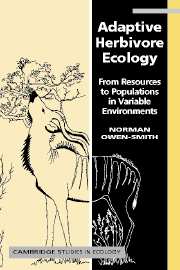Book contents
- Frontmatter
- Contents
- Acknowledgements
- Acronym and symbol conventions
- 1 Conceptual origins : variability in time and space
- 2 Consumer–resource models : theory and formulation
- 3 Resource abundance : intake response and time frames
- 4 Resource distribution : patch scales and depletion
- 5 Resource quality : nutritional gain and diet choice
- 6 Resource constraints : physiological capacities and costs
- 7 Resource allocation : growth, storage and reproduction
- 8 Resource production : regeneration and attrition
- 9 Resource competition : exploitation and density dependence
- 10 Resource-dependent mortality : nutrition, predation and demography
- 11 Habitat suitability : resource components and stocking densities
- 12 Resource partitioning : competition and coexistence
- 13 Population dynamics : resource basis for instability
- 14 An adaptive resource ecology : foundation and prospects
- References
- Index
1 - Conceptual origins : variability in time and space
Published online by Cambridge University Press: 04 February 2011
- Frontmatter
- Contents
- Acknowledgements
- Acronym and symbol conventions
- 1 Conceptual origins : variability in time and space
- 2 Consumer–resource models : theory and formulation
- 3 Resource abundance : intake response and time frames
- 4 Resource distribution : patch scales and depletion
- 5 Resource quality : nutritional gain and diet choice
- 6 Resource constraints : physiological capacities and costs
- 7 Resource allocation : growth, storage and reproduction
- 8 Resource production : regeneration and attrition
- 9 Resource competition : exploitation and density dependence
- 10 Resource-dependent mortality : nutrition, predation and demography
- 11 Habitat suitability : resource components and stocking densities
- 12 Resource partitioning : competition and coexistence
- 13 Population dynamics : resource basis for instability
- 14 An adaptive resource ecology : foundation and prospects
- References
- Index
Summary
The motivation to write this book stems from a long-felt uneasiness with the theoretical models that throng the ecological literature. Having originally studied the physical sciences at university, I fully recognized the power of fundamental theory in science. But the mathematical models that I found in the ecological literature were discordant with the world that I encountered as a field biologist. Their conventional assumptions of uniform environments and near-equilibrium conditions seemed far divorced from the continually changing environments that I experienced in African savannas. Biological persistence seemed to be more a matter of coping with variability than balancing around some equilibrium state. The vast superabundance of green vegetation at one time of the year contrasted sharply with the sparse dry remnants at a later stage. Conditions were also spatially heterogeneous, with certain localities retaining green glades at times when only standing brown hay remained elsewhere. Furthermore, conditions fluctuated widely between years, some years being quite benign, others severely adverse. Animals persisted by responding to this variability in numerous ways: adjusting what they ate, the habitats they occupied, and when they reproduced. Conventional mathematical models omitted the basic features that distinguish biological from physical systems: temporal variability, spatial heterogeneity, and adaptively changing responses over different time scales.
- Type
- Chapter
- Information
- Adaptive Herbivore EcologyFrom Resources to Populations in Variable Environments, pp. 1 - 12Publisher: Cambridge University PressPrint publication year: 2002



